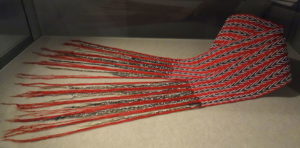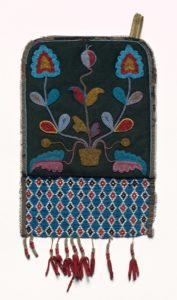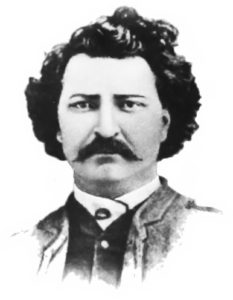Read the Following Selection
Read the following selection, or click on the play button below to listen aloud.
The Métis
Canada’s Métis are people who descended from both First Nations and European people. The name Métis was first used in the mid-1600s when First Nations began marrying Europeans. The groups met because the Indigenous people helped the Europeans with the fur trade. The Métis live mostly in Alberta, Saskatchewan, Manitoba, and Ontario. Today there are about 600,000 Métis in Canada.
Capots and Ceintures Fléchées

Ceinture fléchée, 1825-1875, Royal Ontario Museum
Fur traders depended on the Métis to guide them through the Canadian wilderness, help them live in the woods, and supply them with pemmican. This was food made from dried meat, melted fat, and berries, which lasted well on the trails. The Métis could speak the languages of many groups and were excellent buffalo hunters.
The Métis wore a combination of Indigenous and European styles. The men were dressed in moccasins, deerskin pants, and a long coat called a capot (pronounced ka-poe). Around his waist, a Métis man would often wear a specially woven sash known as a ceinture fléchée (san-toor flesh–ay) — it means “arrowed sash.” Because the sashes could be used to carry items like rope and saddle blankets, among other things, they became very important and today are a symbol of the Métis.
Métis originals

Métis beaded bag
Fiddle-playing and step-dancing are two things that the Métis are known for. The music and dancing began with the French and Scots, but the Métis added their unique flavour. They made their own fiddles and included steps from First Nations dances.
Métis beadwork is also famous. Using tiny beads, the Métis created beautiful flowers on bags, gloves, jackets, and more. As well, Métis crafters embroidered flowers from silk thread.
The Red River cart was also invented by the Métis. This was a large, two-wheeled cart that had no metal in it at all—nails were very expensive in those days. This cart was light enough to float across streams but could still carry heavy loads.
Louis Riel

Louis Riel
The most famous Métis is Louis Riel. He was a leader in the Métis Red River Settlement in what is today Manitoba. In 1868 he feared the Hudson’s Bay Company was about to give Canada a huge chunk of that land. The Métis weren’t consulted, so Riel and his followers moved in to stop Canadian officials from entering the settlement.
Riel tried to negotiate with the Canadian government but when talks failed, the Métis fought against settlers and soldiers for the land. This was known as the Red River Rebellion or the Red River Resistance.
In 1869, Canada recognized Métis rights and created the province of Manitoba, with Riel as its leader. But during the Rebellion, Riel’s government had hanged a non-Métis man. After leading a second Métis rebellion (the Northwest Rebellion) in 1885, Riel turned himself into the Canadian militia and eventually was hanged for treason. Was Riel a hero for defending western Canada? It is still debated by some Canadians.
Now, show what you know!
Complete some questions about the reading selection by clicking “Begin Questions” below.









